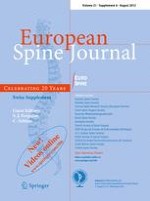01-08-2012 | Original Article
Is spinal stenosis assessment dependent on slice orientation? A magnetic resonance imaging study
Published in: European Spine Journal | Special Issue 6/2012
Login to get accessAbstract
Introduction
Lumbar spinal stenosis (LSS) treatment is based primarily on the clinical criteria providing that imaging confirms radiological stenosis. The radiological measurement more commonly used is the dural sac cross-sectional area (DSCA). It has been recently shown that grading stenosis based on the morphology of the dural sac as seen on axial T2 MRI images, better reflects severity of stenosis than DSCA and is of prognostic value. This radiological prospective study investigates the variability of surface measurements and morphological grading of stenosis for varying degrees of angulation of the T2 axial images relative to the disc space as observed in clinical practice.
Materials and methods
Lumbar spine TSE T2 three-dimensional (3D) MRI sequences were obtained from 32 consecutive patients presenting with either suspected spinal stenosis or low back pain. Axial reconstructions using the OsiriX software at 0°, 10°, 20° and 30° relative to the disc space orientation were obtained for a total of 97 levels. For each level, DSCA was digitally measured and stenosis was graded according to the 4-point (A–D) morphological grading by two observers.
Results
A good interobserver agreement was found in grade evaluation of stenosis (k = 0.71). DSCA varied significantly as the slice orientation increased from 0° to +10°, +20° and +30° at each level examined (P < 0.0001) (−15 to +32% at 10°, −24 to +143% at 20° and −29 to +231% at 30° of slice orientation). Stenosis definition based on the surface measurements changed in 39 out of the 97 levels studied, whereas the morphology grade was modified only in two levels (P < 0.01).
Discussion
The need to obtain continuous slices using the classical 2D MRI acquisition technique entails often at least a 10° slice inclination relative to one of the studied discs. Even at this low angulation, we found a significantly statistical difference between surface changes and morphological grading change. In clinical practice, given the above findings, it might therefore not be necessary to align the axial cuts to each individual disc level which could be more time-consuming than obtaining a single series of axial cuts perpendicular to the middle of the lumbar spine or to the most stenotic level. In conclusion, morphological grading seems to offer an alternative means of assessing severity of spinal stenosis that is little affected by image acquisition technique.





